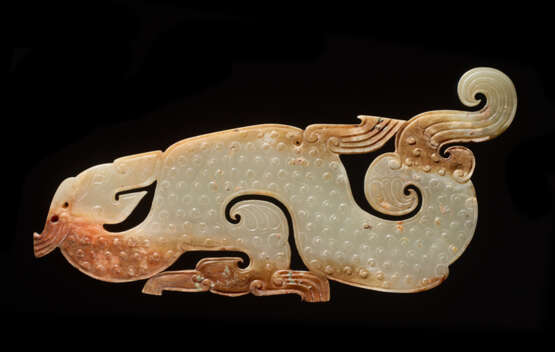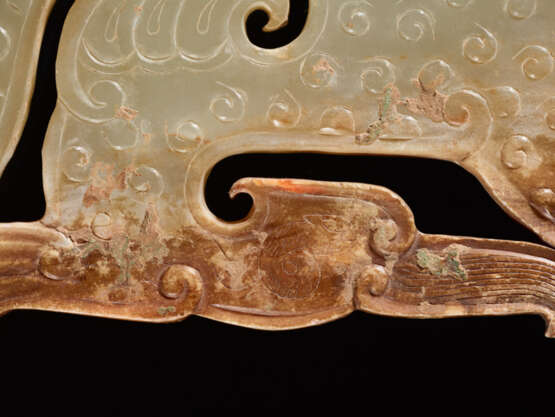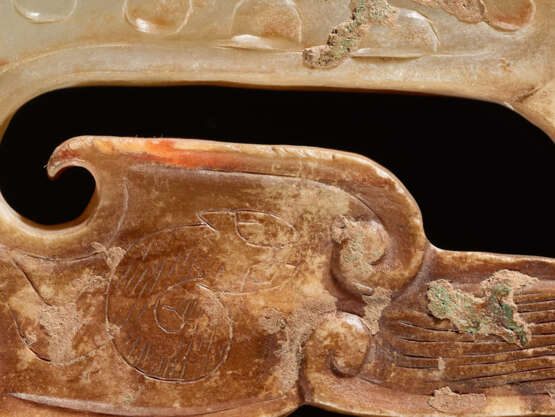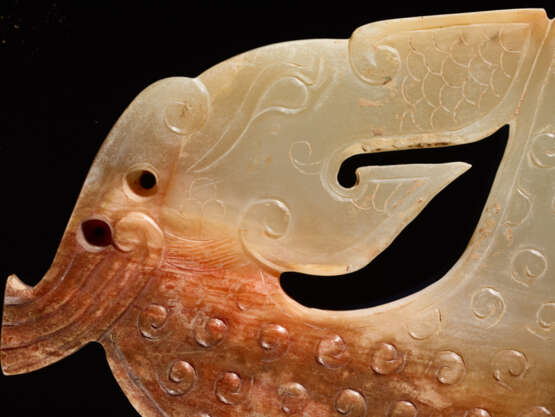ID 7377
Los 39 | A SUPERB AND EXTREMELY RARE LARGE DRAGON-SHAPED PLAQUE CARVED IN WHITE JADE
Schätzwert
€ 24 000
龍形玉佩-東周戰國時代晚期, 公元前4世紀-前3世紀
Length: 20.5 cm
長 20.5 厘米
This extraordinary plaque in the shape of a dragon is impressive in size, design and workmanship, and displays the truly high level of artistry of the Eastern Zhou carvers. The s-shaped dragon is presented with a turned-back head, curling and truncated appendages and cut-out areas. Despite the flattened, compressed form, it is nonetheless highly realistic with details and carving techniques that fully express the character, posture and power of the mythical animal.
Both sides of the dragon are decorated with the same pattern: the body is engraved with small spirals in relief, referred to as the ‘grain pattern’, or gu wen 穀紋 in Chinese, and carved parallel lines in low relief that follow the curves of the crest, tail and appendages. There is a thin, engraved border that follows the contour of the dragon’s body, and except for the round, curving tail and head, all the other appendages are truncated.
What is most unusual about this particular plaque are the meticulous details and unique additional decorative patterns. The features on the head of the dragon are designed with carved and incised lines: the snout is marked with a scale-like pattern, a flower-like motif is incised on the cheek, and a carved border with finely incised parallel lines separates the head from the body. Further detailed areas include the clearly defined claws, curled appendages and other subtle markings. There are also three conical holes that have been drilled from one side only: two in the crest area on the head and one in the upper area of the jade near the curve of the arched back. Four cut-out areas highlight the open mouth, the central curve of the body and tail, and the area of the bottom limb, which rests on a base. There is also a very small curling snake, almost hidden from sight, incised in the central area of the bottom, near the dragon’s lower limb. The snake is framed by additional finely engraved, parallel lines on one side, wider lines on the other side, and carved swirls that decorate the squared-off base.
The object is carved from an exquisite white Khotan jade that has maintained its translucency in most areas, except for a brownish strip that runs from the dragon’s crest across the bottom area of the base, and a thin line running across the top side. There is also a more concentrated area in the truncated appendage and on the base of the upper curled appendage, as well as some brown and orange speckles, and occasional small whitish and greyish patches: the jade is smoothly polished, except for those areas where the alterations have made them a bit rough to the touch.
Literature comparison/Archaeological sites: There are no exact counterparts to this extremely detailed dragon plaque: some of the closest examples are represented by similar jades in the Harvard Art Museums (accession numbers 1943.50.449 and 1943.50.468), published in M. Loehr and L.G. Fitzgerald Huber, Ancient Chinese jades from the Grenville L. Winthrop collection in the Fogg Art Museum, Harvard University, Fogg Art Museum (Cambridge, MA) 1975, nos.422 and 427.
Expertise: Prof. Dr. Filippo Salviati
From an Austrian collection
奧地利老佔有
All jades in this catalogue have been professionally examined, authenticated and described by Prof. Fillipo Salviati. Professor Salviati teaches Chinese and Korean art at Sapienza University in Rome, in the Italian Institute of Oriental Studies. He is a world expert on archaic Chinese jades, having released multiple publications and being cited by renowned auction houses such as Sotheby’s.
| Adresse der Versteigerung |
Galerie Zacke Mariahilferstrasse 112 1070 Wien Österreich | ||||||||||||||
|---|---|---|---|---|---|---|---|---|---|---|---|---|---|---|---|
| Vorschau |
| ||||||||||||||
| Telefon | +00 4315-320 452 | ||||||||||||||
| Fax | +43-1-5320452-20 | ||||||||||||||
| Aufgeld | 27.000 | ||||||||||||||
| Nutzungsbedingungen | Nutzungsbedingungen | ||||||||||||||
| Geschäftszeiten | Geschäftszeiten
|








